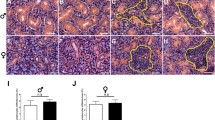Abstract
Sjogren’s syndrome (SS) is an autoimmune disease. Its mechanism and treatment methods are unclear. The purpose of this study was to investigate the effects of rutin (Ru) on SS. Proteomics was used to detect differential proteins in the submandibular glands of normal mice and SS mice. Salivary secretion (SAS) and salivary gland index (SGI) were detected. Oxidative stress and inflammatory cytokine in submandibular glands were detected. The levels of NLRP3, ASC, Caspase-1, IL-1β, and p-NF-κBp65 in submandibular gland tissues and submandibular gland cells of overexpressed calcium-sensing receptor (over-CaR) mice and overexpressed CaR primary submandibular gland cells (over-CaR-PSGs) were detected. In total, 327 differential proteins were identified in the submandibular gland tissues of SS mice compared to control mice. CaR was one of the most differential proteins and significantly increased compared to control mice. Ru could significantly increase SGI and SGI, and inhibit oxidative stress and inflammatory cytokine in submandibular glands. In addition, Ru was shown to further improve SS via regulation of the CaR/NOD-like receptor thermal protein domain associated protein 3 (NLRP3)/nuclear factor kappa-B (NF-κB) signal pathway. Overexpression of CaR counteracted partial activity of Ru. CaR may be an important target for the treatment of SS. In addition, Ru improved the SS via the CaR/NLRP3/NF-κB signal pathway. This study provides a basis for the treatments for SS.







Similar content being viewed by others
Data availability
Data can be requested through the corresponding author.
References
Bianciardi G, Latronico ME, Traversi C (2015) Entropy of corneal nerve fibers distribution observed by laser scanning confocal microscopy: a noninvasive quantitative method to characterize the corneal innervation in Sjogren’s syndrome patients. Microsc Res Technol 78:1069–1074
Bjordal O, Norheim KB, Rodahl E, Jonsson R, Omdal R (2020) Primary Sjogren’s syndrome and the eye. Surv Ophthalmol 65:119–132
Dartt DA (2009) Neural regulation of lacrimal gland secretory processes: relevance in dry eye diseases. Progr Retin Eye Res 28:155–177
Dartt DA, Kessler TL, Chung EH, Zieske JD (1996) Vasoactive intestinal peptide-stimulated glycoconjugate secretion from conjunctival goblet cells. Exp Eye Res 63:27–34
Doughty MJ (2020) On the in vivo assessment of goblet cells of the human bulbar conjunctiva by confocal microscopy—a review. Contact Lens Anterior Eye 43:315–321
Fox RI (2005) Sjögren’s syndrome. Lancet 366:321–331
Hodges RR, Dartt DA (2013) Tear film mucins: front line defenders of the ocular surface; comparison with airway and gastrointestinal tract mucins. Exp Eye Res 117:62–78
Hong J, Zhu W, Zhuang H, Xu J, Sun X, Le Q, Li G, Wang Y (2010) In vivo confocal microscopy of conjunctival goblet cells in patients with Sjogren’s syndrome dry eye. Br J Ophthalmol 94:1454–1458
Kassan SS, Moutsopoulos HM (2004) Clinical manifestations and early diagnosis of Sjogren syndrome. Arch Intern Med 164:1275–1284
Kinoshita S, Kiorpes TC, Friend J, Thoft RA (1983) Goblet cell density in ocular surface disease. A better indicator than tear mucin. Arch Ophthalmol 101:1284–1287
Lee DU, Shin DM, Hong JH (2016) The regulatory role of rolipram on inflammatory mediators and cholinergic/adrenergic stimulation-induced signals in isolated primary mouse submandibular gland cells. Mediators Inflamm 2016:3745961
Pflugfelder SC, Tseng SC, Yoshino K, Monroy D, Felix C, Reis BL (1997) Correlation of goblet cell density and mucosal epithelial membrane mucin expression with rose bengal staining in patients with ocular irritation. Ophthalmology 104:223–235
Shiboski CH, Shiboski SC, Seror R, Criswell LA, Labetoulle M, Lietman TM, Rasmussen A, Scofield H, Vitali C, Bowman SJ (2017) American College of Rheumatology/European League Against Rheumatism classification criteria for primary Sjogren’s syndrome: a consensus and data-driven methodology involving three international patient cohorts. Ann Rheum Dis 76:9–16
Stevenson W, Pugazhendhi S, Wang M (2016) Is the main lacrimal gland indispensable? Contributions of the corneal and conjunctival epithelia. Surv Ophthalmol 61:616–627
Vivino FB, Bunya VY, Massaro-Giordano G, Johr CR, Giattino SL, Schorpion A, Shafer B, Peck A, Sivils K, Rasmussen A (2019) Sjogren’s syndrome: an update on disease pathogenesis, clinical manifestations and treatment. Clin Immunol 203:81–121
Author information
Authors and Affiliations
Corresponding author
Ethics declarations
Conflict of interest
The authors declare no competing interests.
Rights and permissions
Springer Nature or its licensor (e.g. a society or other partner) holds exclusive rights to this article under a publishing agreement with the author(s) or other rightsholder(s); author self-archiving of the accepted manuscript version of this article is solely governed by the terms of such publishing agreement and applicable law.
About this article
Cite this article
He, J., Xu, M. & Wu, S. Rutin alleviates Sjogren’s syndrome via CaR/NLRP3/NF-κB signal pathway. In Vitro Cell.Dev.Biol.-Animal (2024). https://doi.org/10.1007/s11626-024-00893-4
Received:
Accepted:
Published:
DOI: https://doi.org/10.1007/s11626-024-00893-4




